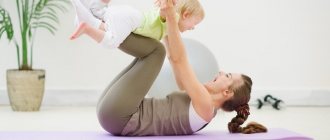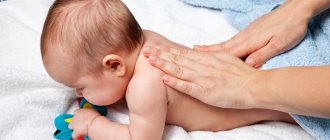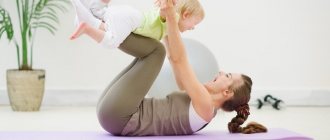Gymnastics is necessary for every person. At the same time, for babies in their first year of life, regular physical exercise not only helps them get stronger physically, but also has a beneficial psychological effect.
Exercise therapy for children under one year old, performed correctly and systematically, allows the baby to quickly begin to walk and talk. Interaction with loving parents improves mood, makes the child active and inquisitive. Of course, the necessary set of exercises and the correctness of their implementation must be monitored by a pediatrician; from the first months of life, physical education must be combined with massage, this allows you to relieve the increased muscle tone characteristic of infants.
It is important!
The benefits of gymnastics are undeniable, but before you start exercising with your baby, you should definitely consult with your pediatrician. During the first weeks after the hospital, he will visit you at home. There are few contraindications against gymnastics for a baby, but they still exist. You should refrain from exercise if the child has skin diseases, problems with the heart and respiratory system, and others. In some cases, a child requires a professional massage, which cannot be replaced by independent gymnastics at home.
What time to do gymnastics
Gymnastics should be done daily, 3-5 1-2 sessions per day. Perform exercises at least half an hour before meals or 1 hour after feeding.
Conditions for classes
- Ventilate the room where you will study with your baby. The room should be warm, but not hot. The optimal temperature is 20-21 degrees. During the massage, the child also takes air baths - an important hardening factor.
- Conduct classes on a flat, hard surface: on a changing or regular table, or the lid of a chest of drawers. A bed or sofa is not suitable for these purposes, as it will sag under the child and there will be no effect from the exercises. To make your baby comfortable, place a thin blanket on the tabletop and cover it with a diaper.
- The child should be in a good mood, calm and active. If he wants to sleep, is capricious or unwell, classes should be postponed.
- The mother should also tune in to communicate with the baby, not rush anywhere, and not fuss.
- Gymnastics should be combined with air baths. Undress your baby and remove his diaper. Let nothing hinder his movements.
- While doing the exercises, talk to your baby, recite nursery rhymes, and sing songs. You can turn on soft background music.
What can a baby be taught at the age of 8 months?
From a very early age, children learn everything from the example of adults. Therefore, an 8-month-old child also needs to be taught by example.
So, what is useful to teach your fidget at 8 months?
- Use objects for their intended purpose (roll a car, push a ball, press buttons, turn on musical toys).
- Use household items (spoon, mug, towel or napkin).
- Imitating adults, cover the pan with a lid, close the box, screw on the cap of the bottle.
- Beat a drum or tambourine.
- Drink through a straw.
- Play the trumpet.
- Disassemble the pyramid, destroy the tower of cubes.
- Use a sorter.
- Place the cup inserts inside each other.
- Correlate the action with the sound (“bang” - if something has fallen, “am” - when they are feeding, “beep” - if you need to drive a car).
- Find familiar objects in books.
- Slapping the water in the bathroom, catching floating toys, pouring water from containers.
However, a mother cannot spend the whole day studying with her child - she needs to have time to do daily household chores. At this time, the child becomes an observer. But these hours can also pass with benefit for him if the mother comments on her actions, speaking in clear, short phrases, what she is doing and why. This will help the baby to understand the world around him more fully, and will also accelerate the development of speech. It is possible to develop a child in the process of household chores; it is quite simple.
The same applies to walks. While on the street, the baby needs to be told what is happening around him, describe the surrounding objects, people, animals, trees, tell him what the weather is like, what purchases need to be made in the store, etc.
Show your child what he can touch in the house and what is strictly prohibited. Be sure to explain why. For example, clearly show that you touched a hot iron or kettle and it became very painful for you.
Exercises for babies up to 2 months
- Place your baby on his back. With both hands, make light stroking movements from the center of the chest to the sides - 3-5 times.
- Stroke the baby's tummy in a clockwise circular motion - without effort, without pressing.
- Let your baby wrap his fist around your finger. Stroke his arms one by one, moving from the hands to the shoulders – 5-6 times. Then gently massage your brushes.
- Stroke your baby's legs 5-6 times from the feet to the hips. Then with your thumb, gently press on the baby’s foot at the base of the toes - the baby will reflexively press them. Maintaining light pressure, move along the foot to the heel. Repeat 5 times for each leg.
- Turn the baby onto his stomach. Stroke his back from head to buttocks with the back of your hand 6-7 times.
- Place your palms on your baby's feet and apply gentle pressure as if pushing them forward. The baby will make reflexive attempts to crawl. The exercise helps strengthen the muscles of the back and abdomen, and trains the legs.
- Turn the child onto his side. Without pressing, move your finger along the spine from top to bottom. The baby will reflexively arch his back and return to his original position. Do the exercise 1-2 times on each side.
Exercise sets
All given sets of exercises and massage elements are recommended exclusively for healthy babies.
1-3 months
Only reflex exercises are performed with newborns. They are based on the use of the baby’s innate reflexes:
- Laying on the tummy. At the same time, the child reflexively turns his head to the side, and the muscles of the neck and back are trained. If at this time you place your palms on your heels, creating a slight emphasis, he will try to move forward.
- Stroking the feet. You should carefully run your finger along the child’s feet; he will clench and unclench his fingers.
- The baby is placed on its side and carefully rubbed with fingers on both sides of the spine, about a centimeter from the spinal column. At the same time, the baby stretches his back.
- Gently stroke the baby's arms and legs, from the toes up to the shoulders and hips.
- The baby is placed on his back, the legs are pulled up to the stomach, the arms are crossed on the chest, the head is also easily directed towards the chest. This pose is called "embryo". The baby should be secured for 0.5-1 minute.
- Holding the child under the armpits in a vertical position, the feet touch the table, and the baby will definitely begin to move his legs.
- From 2 months you can perform a “bicycle” with your child; the legs are bent at the knees, pulled up to the stomach and carefully “pedaled.”
Finish the gymnastics by stroking the tummy clockwise. This improves digestion and relieves the baby from colic. All exercises are done carefully and are accompanied by gentle speech and a smile.
4-6 months
The child has grown up, and the set of exercises becomes more complex. From 4 months you can swing him on a ball. The baby is placed on his tummy on a special ball with arms and legs spread out to the sides. Care must be taken that it does not slip off the ball. Then, the exercise is repeated with the child lying on his back. This type of gymnastics stretches the spine and strengthens the back muscles.
- Circular movements with your hands. The arms are crossed on the chest, then pulled up and returned through the sides to their original position.
- Turns on your stomach. They place a favorite toy on the side of the child and gently encourage the baby to turn in its direction, then help him roll over onto his tummy.
- Supporting the baby under the arms helps him sit down and then straighten up.
- The child is placed in the palm of his hand on his stomach, the baby’s legs rest against the chest of the person performing the exercises with him, and the baby is lifted up imitating an “airplane.”
The massage includes stroking, rubbing, and light tapping.
7-9 months
After six months, new ones are added to the familiar and favorite exercises.
- Allowing the child to firmly grasp your fingers, pull him up so that he resists while trying to sit up. You should not force your child to sit down, just provide him with support.
- With your baby on his stomach, lightly lift him up with your palms under his tummy, encouraging him to get on all fours. When the arms are strong enough, place a bright toy in front of the child so that the child can crawl to it.
- Game of "cars". The child is placed on his tummy, then his legs are raised so that he moves forward with his hands.
- When practicing on a fitball (special ball), you should rock the baby and support him by the legs and allow him to reach the bright toy lying near the ball.
A set of exercises at this age takes 30 minutes.
10-12 months
At this age, the baby is already moving very actively, many begin to walk.
The child should be encouraged to collect bright toys and put balls in a basket. If the child does not walk on his own, you need to lead him under the arms and organize joint crawling competitions.
Joint fiddling and climbing over a gymnastic stick placed on the floor strengthens muscles well. Of course, the baby should be supported, helped, and encouraged in every possible way.
Exercise therapy for 1-year-old children should not be tedious or too complicated.
Turn your activities into a game and then together with your child you will receive a lot of positive emotions.
Exercises for babies 2-6 months
Gymnastics for babies over two months of age should also begin with a light massage. Under no circumstances do we press on the baby’s skin or apply any force. We add more complex exercises to the previous complex:
- After massaging your hands, let your baby hold your thumbs and spread his arms to the sides. Having fixed them in this position for a couple of seconds, cross the baby’s arms over his chest. Repeat the exercise several times, alternating hands: first the right one on top, then the left one.
- After massaging the legs, grab your baby's shins. Perform the “bicycle” exercise: bend your legs one by one, pressing them to your stomach. Then bend both legs at the same time several times.
- Grab your baby's torso under the arms and lift him vertically. Let him touch his feet—not his toes—to a flat surface. He should reflexively step with his legs, as if walking. It is important to keep the baby suspended. The baby should not fully lean on his legs. They, like the baby’s spine, are not yet ready for such loads.
More complex complexes must be discussed with your doctor. Remember, every child is unique, you need to approach classes taking into account the individual characteristics of your baby.
Massage and gymnastics for a baby 8 months old - examples of exercises
At 8 months, a child can already sit without support, sit independently from a position on all fours, crawl on all fours and on his stomach, stand independently near a support, some babies already begin to stomp their feet (walk), leaning on the hands of an adult or along a support, for example, a playpen . The main task of massage during this period is to strengthen the muscles of the back, abdomen and legs to prepare them for walking.
The baby is already sitting well, he can not lean on anything with his arms and back, but sit calmly and play with different objects, reach them from a sitting position. At 8 months, the baby, as a rule, already reaches a high crawling speed, he quickly gets to any objects, and if the object of interest to him is at a height, for example, lying on a chair, then the baby can crawl to the chair and, leaning on it, stand up, to reach the toy.
The baby’s speech is also actively developing, he clearly pronounces paired syllables : ma-ma, pa-pa, dyad-dya, ba-ba, etc. Stimulate his speech, talk to your child more often, leaf through books with him and tell him what is written in them , name the names of all objects that come to his hand, parts of the body. For example, a baby reaches out to a toy cat, say: “This is a cat, he’s white, look: here are his ears, here’s his nose, here are his eyes, here are his paws, his tummy, his tail.” During massage and gymnastics, comment on all your movements. Maybe the baby still doesn’t quite understand you, but such activities will not be in vain; in a couple of months, the baby himself will point his finger at all the objects and demand that you name them.
Since the baby is now becoming very active and cannot sit still for a long time, you will have to actively entertain him during gymnastics . Perhaps the massage will already fade into the background; it is unlikely that the baby will lie down even for 10-15 minutes in place while you massage each arm and leg in turn. Therefore, gymnastic exercises that will stimulate the child’s motor skills are now taking first place. As for massage, do not forget to regularly massage your palms and feet, as it develops the child’s fine motor skills, which will help the baby speak faster and develop better mentally.
conclusions
- Gymnastics strengthens muscles, gives the baby a good appetite, healthy digestion and sound sleep.
- Classes should be carried out half an hour before meals or 1 hour after, in a ventilated room, on a flat, hard surface.
- When working with a newborn, it is enough to make light stroking movements: from the center of the chest to the sides, from the hands to the shoulders, from the feet to the hips, from the neck to the buttocks. The tummy should be stroked in a clockwise circular motion.
- As the baby gets older, you need to add reflex crawling and walking, straightening the back in a side position, and bending the arms and legs to the exercises.
- The technique of performing gymnastics for infants should be agreed upon with a doctor. If you are unsure how to do an exercise, ask a massage nurse to teach you. Unskillful movements can harm the child.











